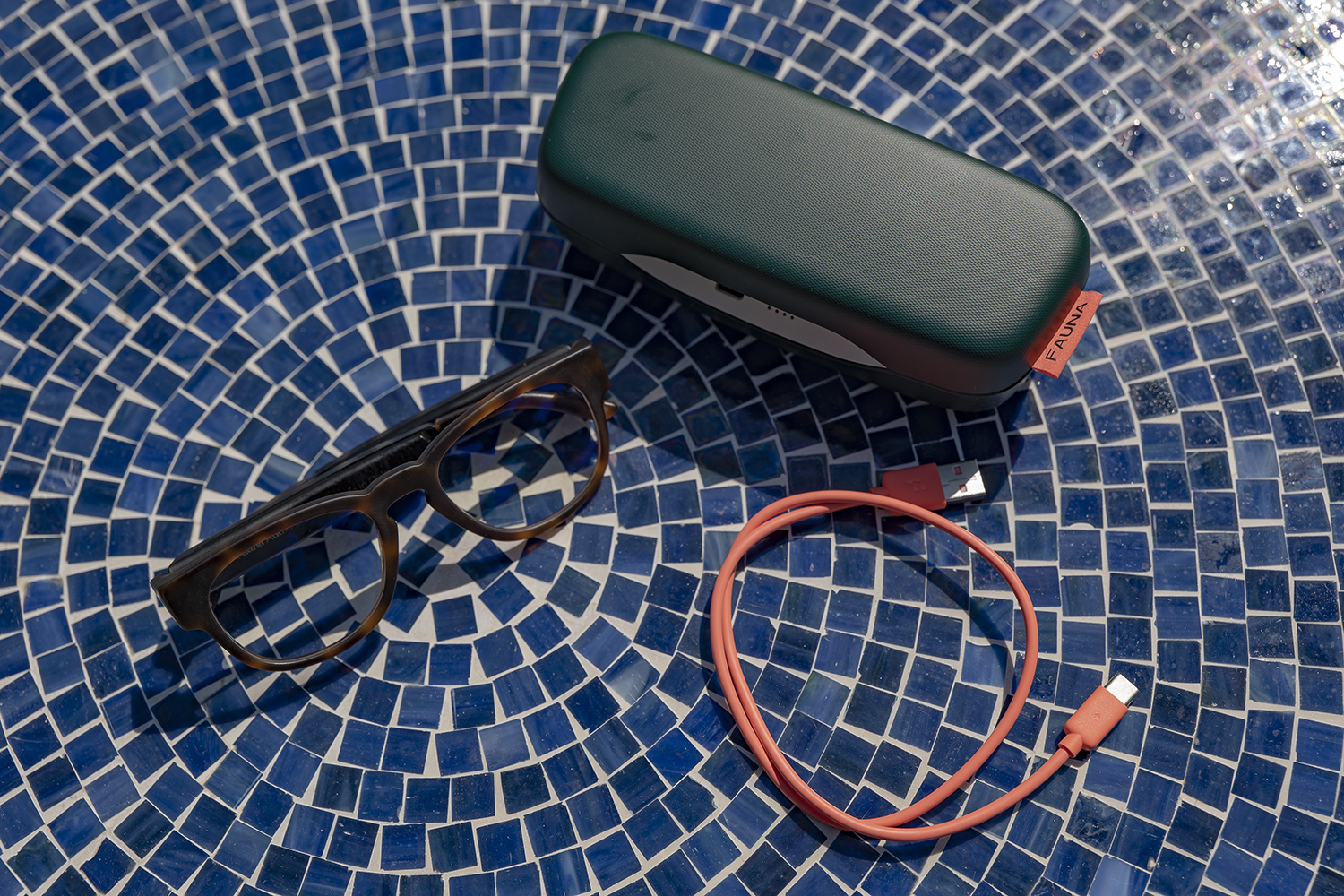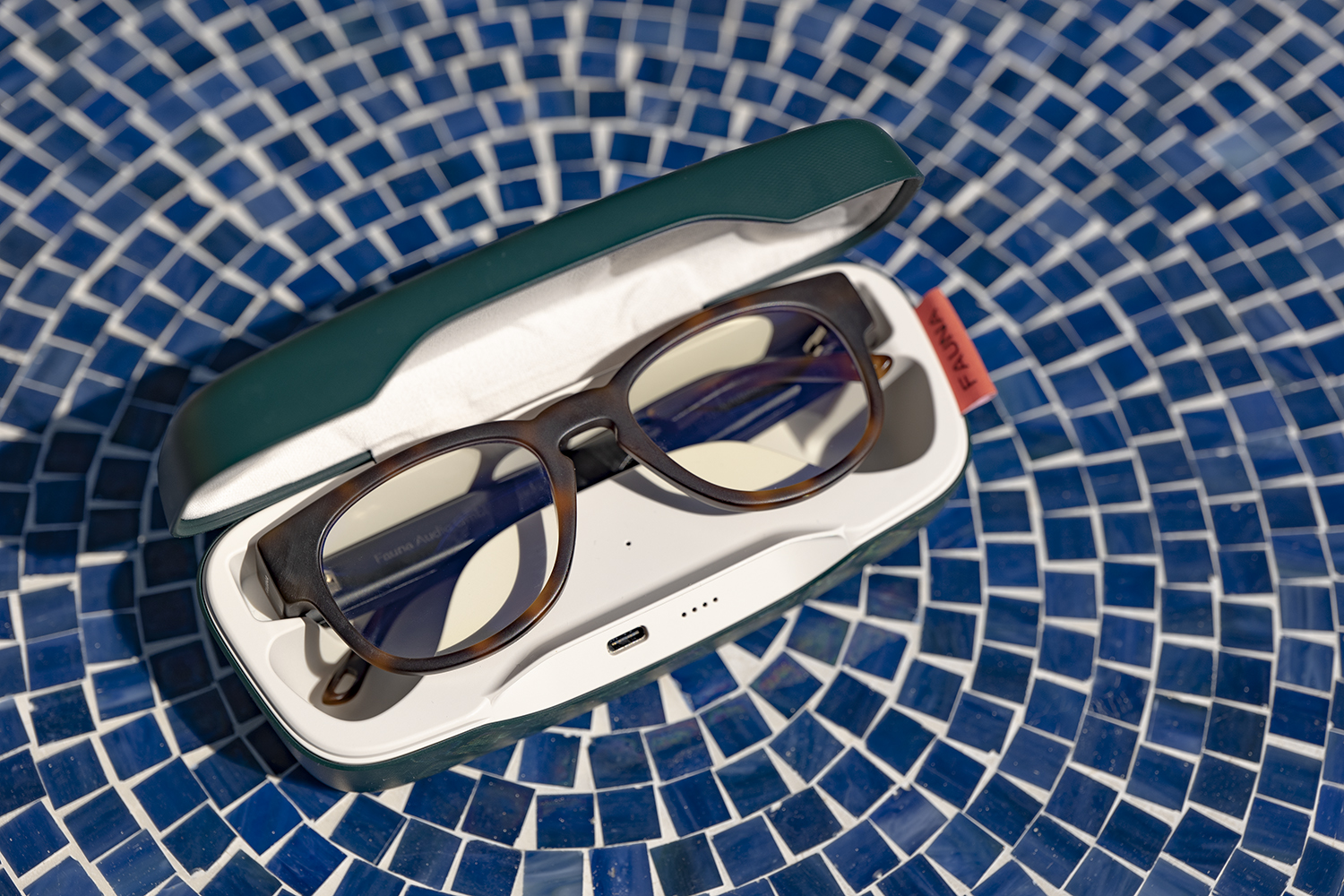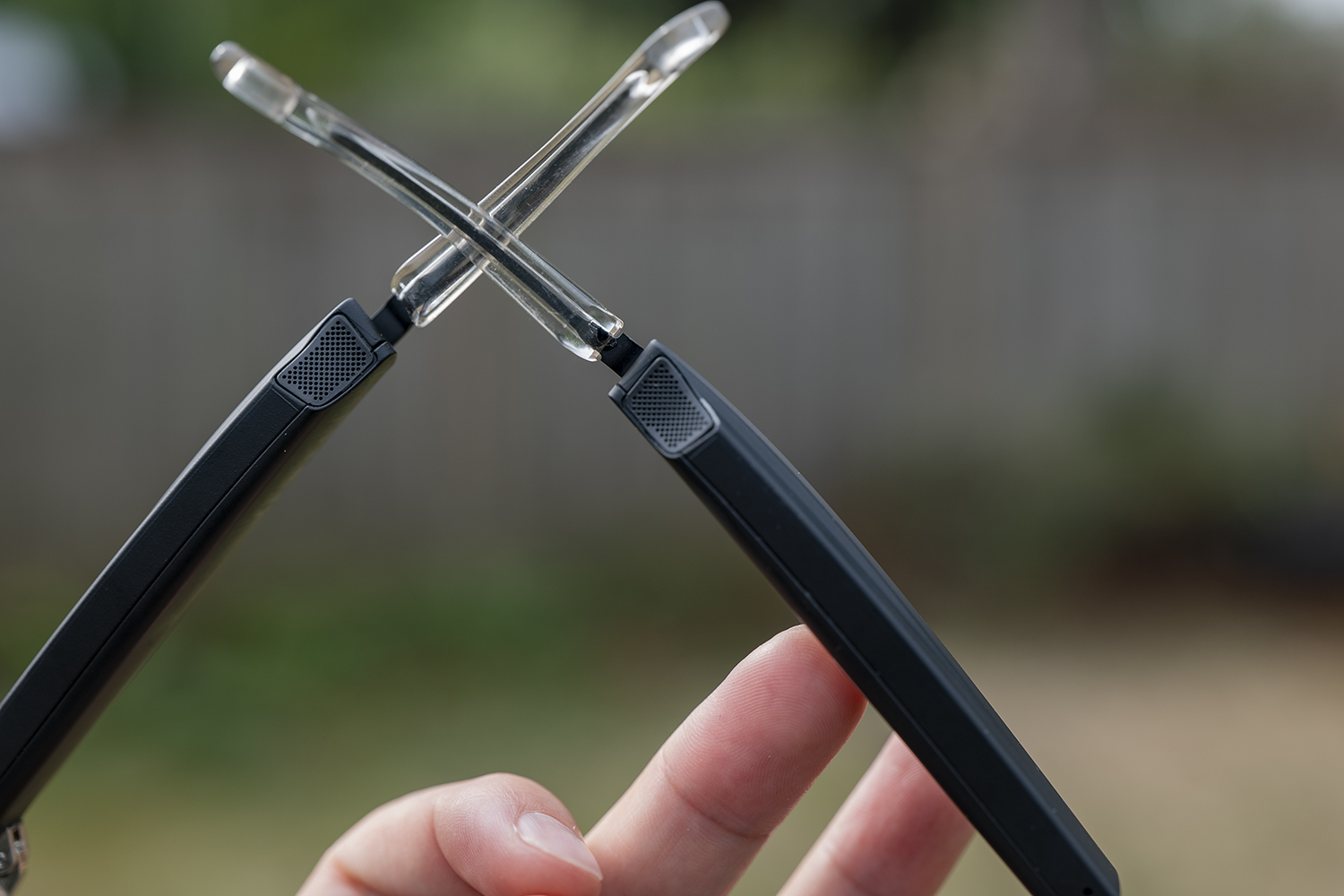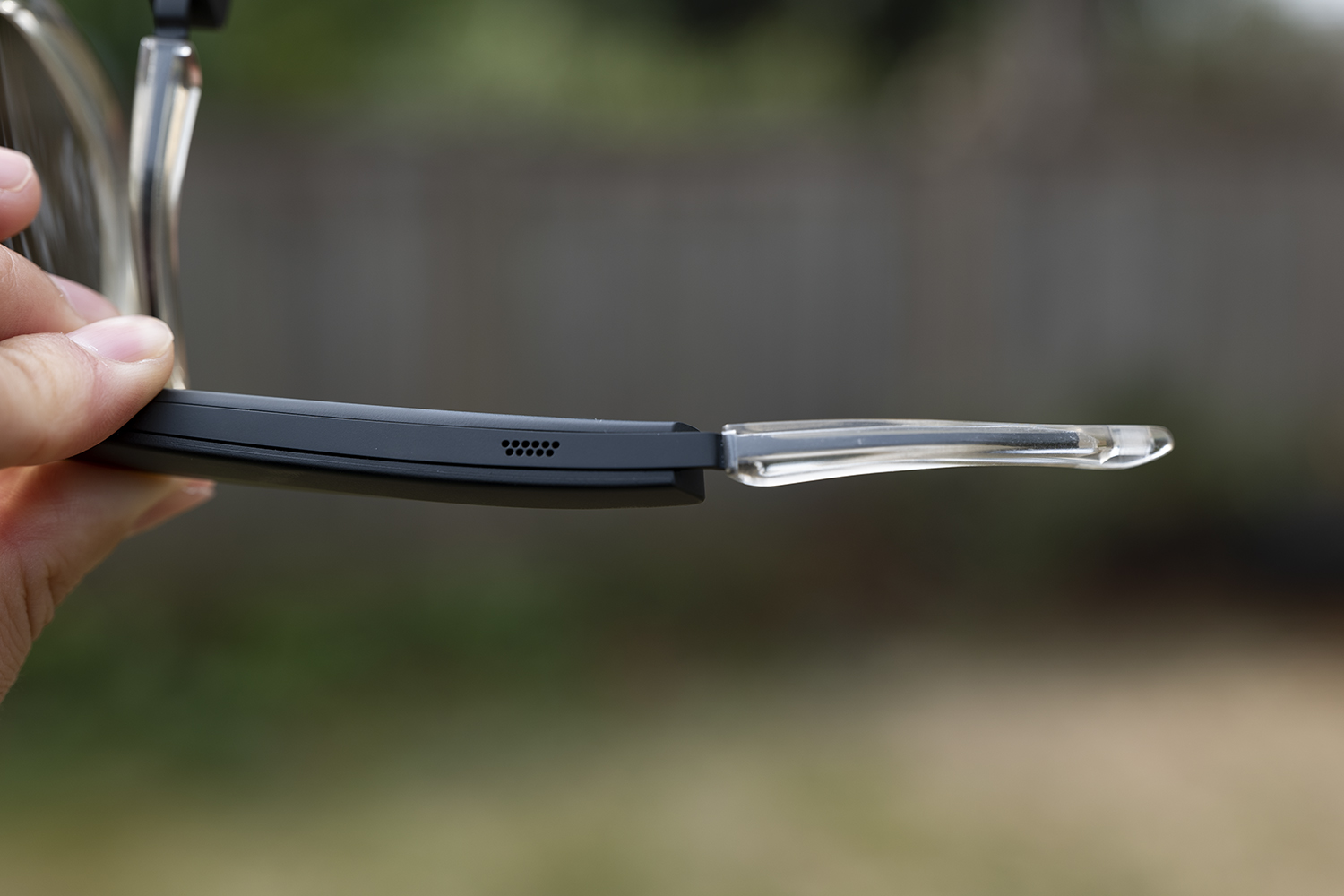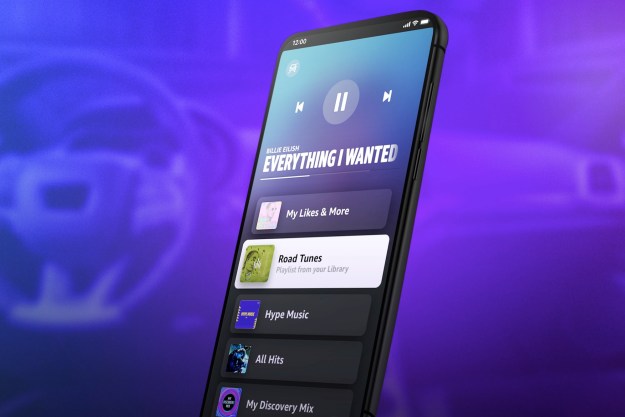
“Though audio quality is sub-standard, the attention paid to design and aesthetics makes Fauna hard to put down.”
- Excellent build quality
- Light, comfortable
- Great call quality
- Lenses can easily be swapped by an optician
- Tinny, low-bass audio
- Confusing controls
- Subpar battery life
Technology in optical wearables is in a weird place, one that I think stems from consumers not sure what they are or should be. Google Glass, what were likely the most well-known smart glasses, failed. In a more focused branch of that kind of wearable, Bose — the next biggest name in this segment — was thought to have exited the audio glasses market unceremoniously in early 2020, but recently announced several new pairs. However, pricing and availability of those have not been revealed, and right now Fauna is one of only a few players currently active in the audio glasses game.
The company’s product, also called Fauna, is simple enough: Glasses that look good and function as listening devices. The biggest hurdle for someone, though, might be to ask why Fauna over any number of headphone or earbud choices. Add to that, at 200 euros (about $225) at their introductory price (which is 20% down from their full 250 euro cost), they’re not a small investment that’s easy to pick up and try. People understand the need for earbuds, but will they “get” audio glasses?
Let’s take a look at what Fauna are they trying to be, and answer whether or not they’re good at it.
More than a feeling
From the box to the way they feel on your head, Fauna absolutely nails the aesthetics. The orange/pink branding on their website is carried over to their packaging and it looks really slick. That same orange/pink is a nice accent on the charging case and the included USB-C cable. The case exterior is mostly dark green which looks nice and doesn’t bring too much attention to itself.
The glasses fit nicely inside, though they don’t magnetically attach to the charging pins as you might expect due to how common that feature is with earbuds. Yet, you wouldn’t expect your normal reading glasses or sunglasses to magnetically attract to their case, so why should they here? From that perspective, Fauna did an excellent job with the design.
From the box to the way they feel on your head, Fauna absolutely nails the aesthetics.
Going back to packaging, I think it is often underappreciated how much good packaging matters for electronic devices. Fauna’s box experience was right up there with Apple’s top-tier packaging, and I can’t think of higher praise to give them.
It should also be mentioned that the packaging was nearly all cardboard and paper, with the exception of small plastic films that covered the charging contacts. I like packaging that isn’t excessive in bits of plastic that are going to end up in a landfill, so it’s nice to know that almost all of what Fauna ships can be easily recycled or composted.
Looking sharp
The idea that an everyday item could also crossover and be a listening device sounds intriguing. I like the idea of not needing headphones to enjoy media, and the Fauna really do deliver on that by packing headphone tech into glasses that are only a bit heavier than my prescription glasses.

On that note, it is rather remarkable how lightweight Fauna are. They clearly stuffed a lot more into a glasses frame than typical glasses do, but when I wear them I don’t feel the extra weight. I’ve happily worn the Fauna for an entire workday and often forget I’m wearing them at all.
Maybe this is an opinion that is exclusive to me, but I think the Fauna glasses look good. Like, I-would-wear-these-all-the-time good. I can see how some folks might think the sides of the glasses look too thick, but that doesn’t particularly bother me. I’m a fan of thicker rimmed glasses to begin with, and I think the sides don’t look obtrusively large or unwieldy. That thickness is warranted as well, since the drivers are housed in there along with touch controls. More on that later.
The Fauna really do deliver… by packing headphone tech into glasses that are only a bit heavier than my prescription glasses.
Fauna offers four different styles of glasses that almost run the gamut of the thick-rimmed style. I generally like a more squared-off frame than any Fauna offers, but I was pleasantly surprised at how I thought they looked on me. I think their Memor Havana or Levia Black designs do the best job of not making the thick sides of the glasses look too obvious. The company’s Spiro Transparent Brown and Fabula Crystal Brown both have transparent parts, and so the giant non-transparent blocks on the sides seem more evident.

One of the pairs I evaluated has a blue light filter glass made by Zeiss, and that filter makes it easier on my eyes to look at television or computer screens for long periods of time. A second set had the sunglasses glass, which protects against 99% of UVA and UVB light. The quality of the glass in both cases is very good, but should I want to, I could take these to my optometrist and have the lenses swapped out to my prescription.
But how do they sound?
I wish I could continue to laud them with praise, but it is in this one key area that Fauna falls short — these don’t sound particularly good.
While the Fauna do have two MEMs speakers and a dedicated subwoofer above each ear, that implementation of technology just does not translate to high-quality audio. Despite having six drivers, the quality doesn’t match what most earbuds are doing with two.
They don’t sound bad by any means, but they lack a lot of depth in how they portray any music, with bass feeling particularly under-represented. Mids are weaker too than I would like, but the lower registers, despite Fauna’s bass support via those dedicated subwoofers, is the prime weakness. The best way I can compare the sound would be to how laptop speakers from 2009 sounded. If back then you listened to music on your stock speakers like I did, you’ll understand what I mean when I say that music comes off as “tinny.” There is no robustness to music out of the Fauna, and I do miss that when listening to most any track.
These don’t sound particularly good.
I will say that the one type of music that works with this kind of audio quality is the very popular “lofi hip hop music -beats to relax/study to” playlist curated by ChilledCow on both YouTube and Spotify. Because those tracks are already low fidelity, they don’t ask the Fauna to do too much and as a result, I’ve enjoyed that style of music played through Fauna.
You know how it sounds to sit in a hotel lobby that is playing calming, vocal-less tracks? That’s how my entire life sounds while wearing the Fauna and I have to say, it’s pretty nice. Chill, for sure.
But in the same way that you can’t really hear lobby music that well because it’s designed to exist in the background of conversation, the Fauna don’t get particularly loud and relegate any music you’re playing on them nearly to background noise. I have been running them at maximum volume for the entire time I’ve had them and it always feels just a few decibels quieter than I want. If they have to compete with any other sounds around you, they’ll get drowned out very easily.
Weirdly though, while they don’t feel loud, they do a really good job of preventing me from hearing anyone trying to talk to me from more than a few feet away. Something about how the speakers are projecting sound blocks out specifically human vocal tones and volume. So if you’re planning on working in a coffee shop (someday, right?), these will allow the pleasant clatter of that bustle through without distracting you with any specific conversations.
Basically, wearing Fauna is like using headphones with ambient sound passthrough all the time, but at a lower volume and lower fidelity music quality, with the benefit of having glasses on at the same time.
When I swap from the Fauna to my Jabra Elite 75t or my Sony WF-1000XM3s, the difference in quality is painfully obvious. I don’t think Fauna ever intended its audio glasses to go toe-to-toe with dedicated earbuds, but even so the stark difference in quality due to a distinct lack of lower register support on the Fauna makes it impossible to recommend these are primary listening devices over earbuds or headphones.
It should also be noted that, as expected, these have pretty terrible noise isolation. If there is anyone seated next to you, they’ll be pretty clearly able to hear what you hear, especially since you’ll very likely have the volume maximized.
Battery, connectivity, and control
Fauna rates the audio glasses for around four hours of continuous play per charge, which is not particularly good and feels like what we expected out of headphones a couple years ago. These days, some companies are pushing battery life to eight or even 10 hours, and given that the Fauna have significantly more room to work with than earbuds, it’s a bit surprising to see such low estimations.
Additionally, you can only get four full charges out of the case bringing your max use time to a paltry 16 hours per wall charge. Given that glasses are the kind of item you throw on in the morning and wear until you go to bed, the low performance of the battery makes it hard to imagine these legitimately taking the place of either your earbuds or your vision aid glasses.
These audio glasses do a solid job connecting quickly to my iPhone after pairing them the first time (a process identical to all other Bluetooth earbuds, where the glasses enter pairing mode after being removed from their case, and can be added from the Bluetooth menu in your phone settings). I have not had any issues with cutouts or drops, and I even walked my entire backyard with my phone still sitting in my kitchen.
The Fauna support 20 hours per charge of passive connection time, that is to say, with no music playing.
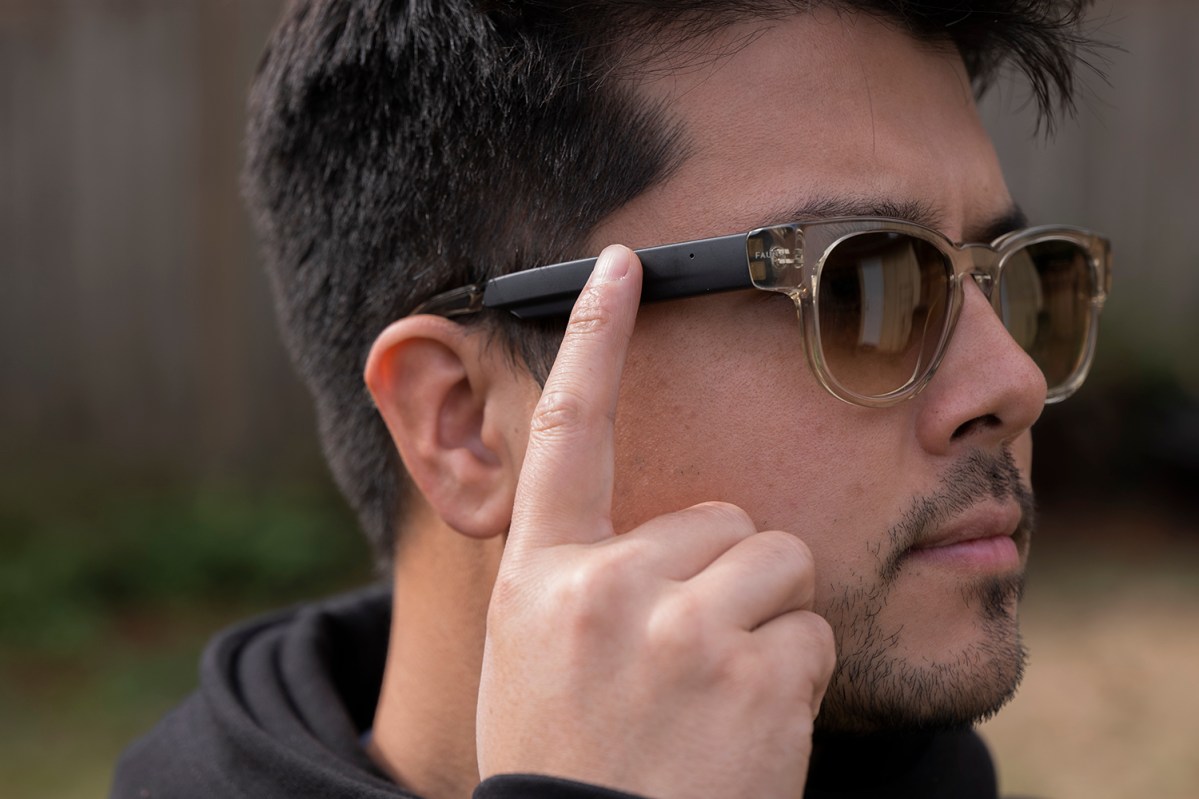
Not to continue to heap on the complaints, but control with the Fauna isn’t great. Let me explain first how the controls work: Each three-inch or so stretch of the sides along your temple line has touch sensitivity with a variety of features.
Overall, these controls are not intuitive.
On the left temple, a double-tap will accept a call, end a call, play music, or pause music. Tapping and holding will decline a call or skip to the next song. Sliding forward will turn the volume down and sliding back will turn the volume up.
On the right temple, double-tap will activate your phone’s voice assistant, and tapping and holding will force the glasses into pairing mode.
Overall, these controls are not intuitive, and in many cases are straight up in contrast to years of training that other devices that came before them have instilled in me. Having the pause/play action be a double-tap and skip be a tap and hold was a strange decision.
Remembering these controls has been a challenging learning curve, and one that only applies to the Fauna and no other devices I have tested. Additionally, sliding forward to turn volume down is a wildly confusing decision. Moving something forward in my mind means turning the volume up and moving back means turning the volume down. Why Fauna chose to reverse this hard-wired inclination is baffling.
Other features
Fauna does succeed in one area of audio: phone calls. Both you and whoever you are talking to will have a wonderful experience, provided you don’t maximize the volume. You’ll hear the other end no problem, and if you keep the volume at 70% or lower, so will who you’re talking to. Kicking up the volume to max will cause the glasses to pick up their own audio signal, giving your listener annoying feedback of their own voice.
I mentioned these weren’t particularly loud to begin with, so turning the volume down might sound counterintuitive. For phone calls though, it works. Even walking down a busy street I was able to have a great phone conversation with my friend, who reported the same back to me.
Fauna’s app adds one feature to the audio glasses that goes beyond just audio. Fauna has special alerts that it calls “Whistles” to help you remember to do things like drink water or fix your posture. I like the idea, but the implementation is … odd.
Despite being called a Whistle, the actual alert is not a whistle, but a robotic male voice that can be programmed to say what is in a text field inside the app.
For the posture whistle, the app pushes a notification that says, “Hey Jaron, it’s time to stand up and stretch out your body.” It’s a bit unsettling, and I wish I could just have it send me a pleasant chime rather than a robotic voice. You can record a different voice, but hearing myself might be even weirder than the robot.
There aren’t a lot of options in the Whistles either, but Fauna does have a direct link to their developers in the app if you come up with an idea you’d like to see, which is nice.
I ended up not using this feature because I personally did not find it helpful, but others may disagree. It’s a nice idea, regardless.

Our take
Fauna put more emphasis on style than it did on audio quality, but maybe that’s not such a bad thing. Though they aren’t going to blow you away with how they sound, they still get the job done and offer an overall experience that keeps you coming back. I found myself complaining about one thing or another to my wife, to which she asked, “Why do you keep wearing them then?”
She’s right, I wore them for a week straight. Despite all their flaws, I still like them.
Are there better alternatives?
As mentioned, Bose recently announced an impending set of new Frames options, but there hasn’t been any note of pricing or availability, so it’s hard to say if they’re worth holding out for. Additionally, Flows makes glasses with a similar aesthetic to Fauna at a lower price, and therefore may be worth considering.
How long will they last?
Fauna offers a two-year limited warranty on its audio glasses, which is exceptional for wearable audio products. Additionally, they feel very well built, so I don’t expect them to just stop working. Don’t drop them, though. They are still glasses and definitely will act as such.
Should you buy them?
Maybe. I know that’s not a solid answer, but these are the kind of “you have to be the right buyer” kind of product. If audio quality is the most important thing to you, then no, give these a pass. But if you like the idea of having background music to your everyday life in a non-obtrusive way, then Fauna makes a good argument for themselves.
Editors' Recommendations
- If you don’t see CBS in 4K on YouTube TV, try this
- When it comes to charging AirPods Pro with USB-C, don’t overthink it
- 4 years of Fire TV Omni updates are good, and bad, and don’t matter
- Don’t buy AirPods right now (if you can help it)
- Emmy’s blind spots: actors and series that should have them, but don’t


